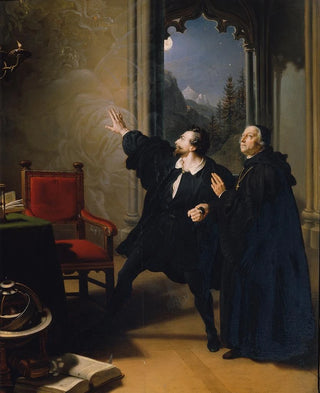Art print | L'heure de la mort de Manfred - Johann Peter Krafft


View from behind

Frame (optional)
In the fascinating world of romantic art, the artwork "L'heure de la mort de Manfred" by Johann Peter Krafft stands out for its emotional intensity and narrative depth. This painting, depicting a tragic and poignant moment, transports the viewer to the heart of the human soul's struggles. The scene, imbued with a dark and melancholic atmosphere, evokes the internal battles of the main character, Manfred, who finds himself at a crossroads between despair and redemption. Through this art print, the artist manages to capture the very essence of suffering and beauty, inviting each viewer to contemplate the nuances of mortality and existence.
Style and uniqueness of the work
Krafft's style is characterized by a remarkable mastery of light and shadow play, which heightens the emotion present in the scene. The chosen color palette, oscillating between dark tones and luminous highlights, enhances the drama unfolding on the canvas. The meticulous details of facial expressions and character postures demonstrate scrupulous attention to human psychology. The composition, meanwhile, is carefully orchestrated to guide the viewer's gaze, inviting immersion into the intensity of the captured moment. Every element of the work, from the drapery of clothing to the background details, contributes to creating an atmosphere both charged with tension and haunting beauty.
The artist and his influence
Johann Peter Krafft, born in 1780, is an emblematic figure of artistic romanticism in Europe. Trained at the Academy of Fine Arts in Vienna, he mastered the influences of past masters while developing a personal style unique to him. Krafft was often inspired by literature, notably by the works of Lord Byron, whose character Manfred is the protagonist of the eponymous play. This literary connection enriches his work, giving it a narrative dimension that goes beyond mere visual representation. Krafft's ability to translate complex emotions through painting has left a lasting imprint on

Matte finish

View from behind

Frame (optional)
In the fascinating world of romantic art, the artwork "L'heure de la mort de Manfred" by Johann Peter Krafft stands out for its emotional intensity and narrative depth. This painting, depicting a tragic and poignant moment, transports the viewer to the heart of the human soul's struggles. The scene, imbued with a dark and melancholic atmosphere, evokes the internal battles of the main character, Manfred, who finds himself at a crossroads between despair and redemption. Through this art print, the artist manages to capture the very essence of suffering and beauty, inviting each viewer to contemplate the nuances of mortality and existence.
Style and uniqueness of the work
Krafft's style is characterized by a remarkable mastery of light and shadow play, which heightens the emotion present in the scene. The chosen color palette, oscillating between dark tones and luminous highlights, enhances the drama unfolding on the canvas. The meticulous details of facial expressions and character postures demonstrate scrupulous attention to human psychology. The composition, meanwhile, is carefully orchestrated to guide the viewer's gaze, inviting immersion into the intensity of the captured moment. Every element of the work, from the drapery of clothing to the background details, contributes to creating an atmosphere both charged with tension and haunting beauty.
The artist and his influence
Johann Peter Krafft, born in 1780, is an emblematic figure of artistic romanticism in Europe. Trained at the Academy of Fine Arts in Vienna, he mastered the influences of past masters while developing a personal style unique to him. Krafft was often inspired by literature, notably by the works of Lord Byron, whose character Manfred is the protagonist of the eponymous play. This literary connection enriches his work, giving it a narrative dimension that goes beyond mere visual representation. Krafft's ability to translate complex emotions through painting has left a lasting imprint on






